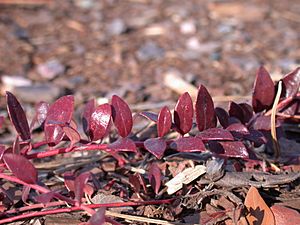Creeping blueberry facts for kids
Quick facts for kids Vaccinium crassifolium |
|
|---|---|
 |
|
| United States Botanic Garden's National Garden, Washington |
|
| Scientific classification | |
| Kingdom: | |
| (unranked): | |
| (unranked): | |
| (unranked): | |
| Order: | |
| Family: | |
| Genus: | |
| Species: |
V. crassifolium
|
| Binomial name | |
| Vaccinium crassifolium Andr.
|
|
| Synonyms | |
|
|
Vaccinium crassifolium, also known as the creeping blueberry, is a type of plant. It belongs to the heath family, which includes other plants like cranberries. This plant grows naturally in the southeastern United States. It is an evergreen shrub, meaning its leaves stay green all year. Its leaves are shiny and can be dark green or even a bit bronze.
Contents
Where Does the Creeping Blueberry Grow?
The creeping blueberry is native to the coastal plain areas. You can find it in Georgia, North Carolina, South Carolina, and southeastern Virginia. It often grows in places called pine barrens. These are open areas with many pine trees. You might also see it along roadsides or in other open, disturbed areas.
How is the Creeping Blueberry Classified?
Vaccinium crassifolium is the only species in a special group called Vaccinium sect. Herpothamnus. Some scientists used to think there was a second type, V. sempervirens. However, most experts now agree that these two are actually the same species. It's interesting to note that even though creeping blueberries grow in North America, they seem more closely related to some Vaccinium species found in South America.
What Are Creeping Blueberries Used For?
Medicinal Uses
The leaves of the creeping blueberry look a lot like those of another plant called bearberry (Arctostaphylos uva-ursi). In some traditional herbal practices, people might use creeping blueberry leaves in place of bearberry leaves.
Growing Creeping Blueberries in Gardens
People have been growing Vaccinium crassifolium in gardens for a long time. It has been cultivated since at least 1787. There are different types, called cultivars, that you can plant. It is often used as a ground cover in landscaping gardens. This means it spreads out and covers the ground, making a nice green carpet.

